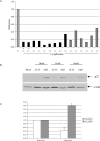A mechanism misregulating p27 in tumors discovered in a functional genomic screen
- PMID: 18069898
- PMCID: PMC2134944
- DOI: 10.1371/journal.pgen.0030219
A mechanism misregulating p27 in tumors discovered in a functional genomic screen
Abstract
The cyclin-dependent kinase inhibitor p27(KIP1) is a tumor suppressor gene in mice, and loss of p27 protein is a negative prognostic indicator in human cancers. Unlike other tumor suppressors, the p27 gene is rarely mutated in tumors. Therefore misregulation of p27, rather than loss of the gene, is responsible for tumor-associated decreases in p27 protein levels. We performed a functional genomic screen in p27(+/-) mice to identify genes that regulate p27 during lymphomagenesis. This study demonstrated that decreased p27 expression in tumors resulted from altered transcription of the p27 gene, and the retroviral tagging strategy enabled us to pinpoint relevant transcription factors. inhibitor of DNA binding 3 (Id3) was isolated and validated as a transcriptional repressor of p27. We further demonstrated that p27 was a downstream target of Id3 in src-family kinase Lck-driven thymic lymphomagenesis and that p27 was an essential regulator of Lck-dependent thymic maturation during normal T-cell development. Thus, we have identified and characterized transcriptional repression of p27 by Id3 as a new mechanism decreasing p27 protein in tumors.
Conflict of interest statement
Competing interests. The authors have declared that no competing interests exist.
Figures





References
-
- Polyak K, Lee MH, Erdjument-Bromage H, Koff A, Roberts JM, et al. Cloning of p27Kip1, a cyclin-dependent kinase inhibitor and a potential mediator of extracellular antimitogenic signals. Cell. 1994;78:59–66. - PubMed
-
- Kiyokawa H, Koff A. Roles of cyclin-dependent kinase inhibitors: lessons from knockout mice. Curr Top Microbiol Immunol. 1998;227:105–120. - PubMed
-
- Fero ML, Rivkin M, Tasch M, Porter P, Carow CE, et al. A syndrome of multiorgan hyperplasia with features of gigantism, tumorigenesis, and female sterility in p27(Kip1)-deficient mice. Cell. 1996;85:733–744. - PubMed
-
- Zhang S, Lawless VA, Kaplan MH. Cytokine-stimulated T lymphocyte proliferation is regulated by p27Kip1. J Immunol. 2000;165:6270–6277. - PubMed
-
- Nourse J, Firpo E, Flanagan WM, Coats S, Polyak K, et al. Interleukin-2-mediated elimination of the p27Kip1 cyclin-dependent kinase inhibitor prevented by rapamycin. Nature. 1994;372:570–573. - PubMed
Publication types
MeSH terms
Substances
Grants and funding
LinkOut - more resources
Full Text Sources
Medical
Molecular Biology Databases
Miscellaneous

